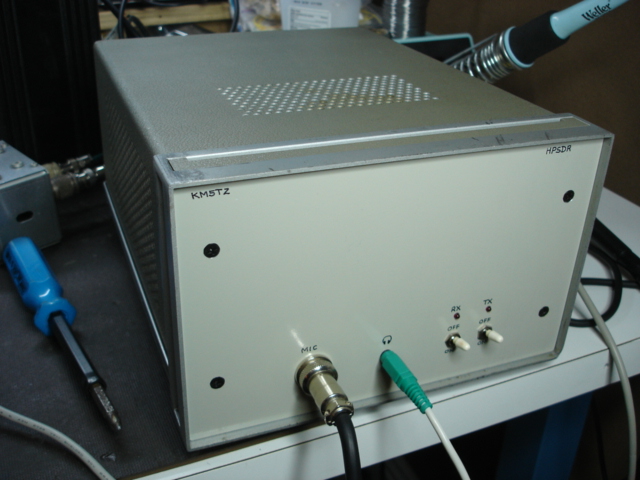
HPSDR Project
This is my HPSDR transceiver. See www.openhpsdr.org
It is built into an old HP436A power meter enclosure. I made a new front panel for it but retained the original back panel and power transformer. The power transformer is used to power the HPSDR boards.... linear power supply = nice and quiet!

Below is a pic of the inside.
I have a Mercury, Penelope, Ozy and Atlas board. All were hand assembled. Mercury has been modified to use an external 10MHz ovenized reference oscillator (top right behind BPF assy).
On the right is a metal box containing a set of bandpass filters and on the left is a 48V 3A switching power supply (to power the PA). This power supply module was quite noisy but I was able to quiet it down considerably by wrapping it in copper tape. Switching spurs are now below the band noise. Since I spend most of my time listening, this supply has its own on-off switch as well. The transformer visible at the bottom is the original HP transformer that is used to power the HPSDR boards and crystal oven assy. I wanted a linear supply to minimize the chances of RF noise.
The fan in the bottom ensures air circulation within the unit. A copper strap pulls heat away from the Mercury ADC and also helps hold this board in place.
The Atlas board was pruned down a little to fit in available space.

Here's a pic of the BPF assy. I designed this board a few yrs ago for my homebrew SDR1000. I've loaded BPF's for 160, 80, 40, 20 and 10. There is also a bypass position and one spare slot for future use. Despite using toroidal inductors, I found these filters were susceptible to noise pickup and so they are mounted inside a shielded enclosure with filtered connections.

The PA (actually this intended to be a driver for a 1KW PA) produces about 25W out from a pair of MRF148's biased in Class A (48V @ 1A ea). It produces a very clean output. The transistors are mounted to an old Pentium processor heatsink and fan assy which provides plenty of cooling (bolted to back). The fan kicks in only when transmitting. These small heatsinks are remarkably efficient and easily capable of dissipating 100W.

You can see the PA below. It is built on a piece of copper clad with cutouts for the transistors. Ferrite size is overkill for this power level - it was built using parts I had on hand.


So far, I am very impressed with the performance of this radio.